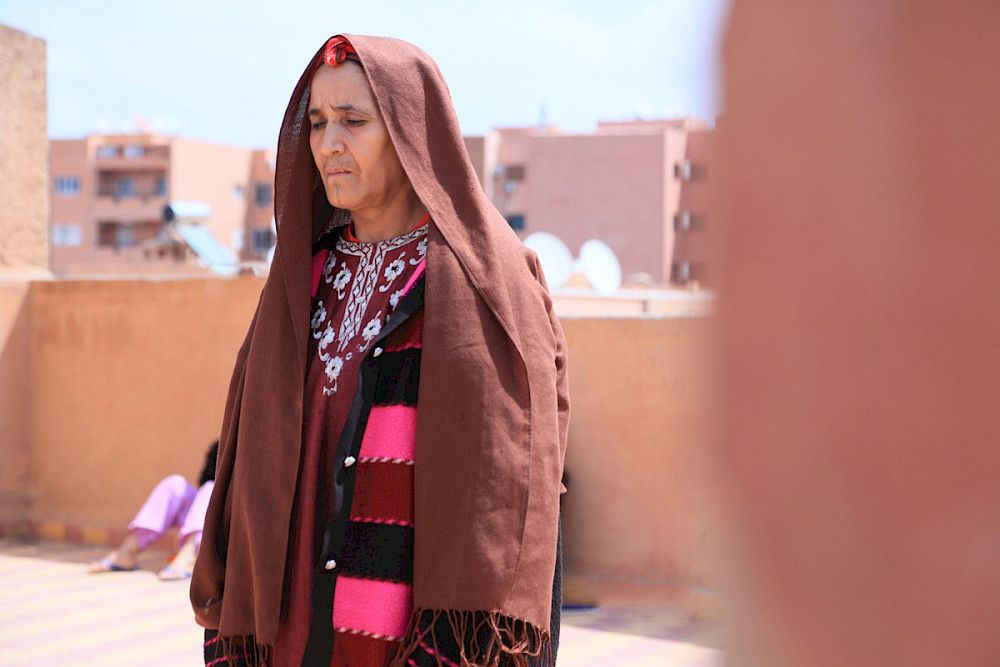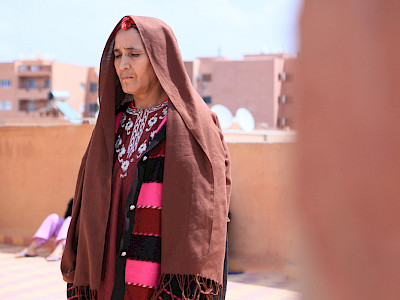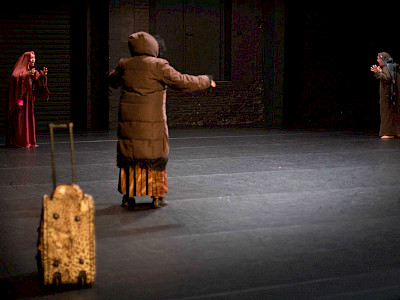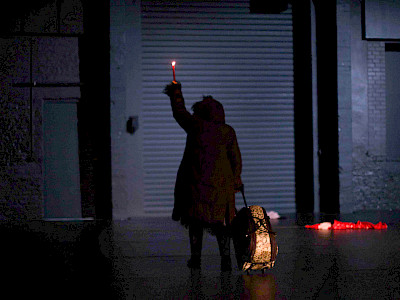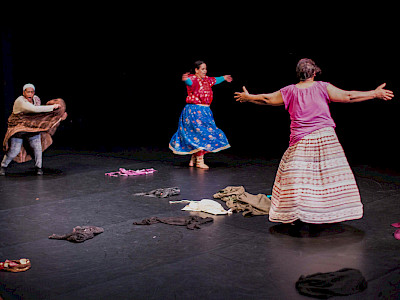15 — 18.05.2016
Bouchra Ouizguen Marrakesh
Ottof
dance
⧖ 1h | € 16 / € 13 | Meet the artists after the performance on 16/05 | After-concert at Le Space on 18/05 at 22:30
It starts off as a seductive and precisely choreographed piece, to the restrained tones of a composition for string instruments by Witold Lutosławski. But gradually, the sound reaches a crescendo. The urge to live bubbles up. All registers fly open. We are sucked into a swirling and unruly universe. Since 2009, choreographer Bouchra Ouizguen has worked with a group of Aitas, traditional, female cabaret artists from Morocco, thus putting her own contemporary approach to dance under pressure and questioning the cultural identity of North Africa. Ouizguen and the Aitas have remained working together, and now form a permanent company. Seven years after their first encounter, we see the women again, scarred by life but glowing with energy and harmony. They dig, search, stay busy – like ants in an anthill. They talk and move, following the voices and gestures of the others. The scenes emanate straight from the heart and life of the women. They don’t dance for nothing; this is a struggle for their female identity, for their own femininity.
See also
Workshop
Interview with Bouchra Ouizguen about Ottof
You’ve been working with the same performers for a number of years. How do you see the company’s work?
We actually favour working as a group in the traditional way, as it were. In today’s context, dancers are increasingly interchangeable; instead I’m looking to share a collective history over the long term. I’ve been working exclusively with the same performers for around seven years now. The core of the group comprises four dancers who have been there since the start and there are now sixteen of us in the company. Five are permanent and involved in all the creations while the others join us from time to time, giving performances every now and then. This applies to everything I do; it’s primarily a human adventure, and then there are productions. I’m not interested otherwise. I need it to take on real meaning in my life. So as a result we’re a connected group, even when we’re not working on productions.
Is the female make-up of your company intentional?
The artistic landscape in Morocco, both theatrical and choreographic, is almost exclusively male. When I first started creating, I was in a group where I was the only woman. After ten years there, I started dreaming of a company that I wouldn’t describe as female, because that’s not the essential thing about it, but that brings women together. I wanted to confront what I’d learnt up to then artistically with the richness of a popular culture “on the ground”, expressed in the main in nightclubs and at weddings. There was a potential for collaboration and creativity in this approach; that’s how I embarked on the research that I’m still doing today. I took a long time to create Madame Plaza because I knew from the outset that it was the first milestone on a long journey.
It’s evident that the same research connects your various pieces.
HA! and Corbeaux are like a stretching, a kind of leverage from the start of Madame Plaza, while Corbeaux is a performance developed from HA! I work on parts of the body – the neck and head – that are essential in dances of the Mediterranean and the East, from Afghanistan to Morocco. Time and again in my work there’s a particular treatment of the voice that’s always central. There’s also an effort to take visual material for the shows from everyday life. That’s the case with the white scarves that the performers wear in HA! and Corbeaux: they all wear them at home so it’s not a costume. What I love is that this accessory signifies a huge number of things and yet with the effect of the repetition of movement, it’s very soon forgotten. We’re seeking as dancers to pass through other dimensions of space and time, both individually and collectively. These propositions call for the audience to find their bearings fairly quickly. There’s no room for hesitation: you’re either in it or outside it.
Is that the case for Ottof too?
What I want is for the dancers to have even more freedom and more space for freedom on stage. I’d like us to really be able to see four intelligences on stage, to give each one of them time and space to speak about what maintains them, what they project in life today. We’re looking for a skeleton, a structure on which to construct the other person’s freedom – it’s obviously contradictory. They have huge potential for impertinence on stage, for freedom: I often wonder whether I’m equal to it all from a choreographic point of view. In a way it’s about going beyond what we did in Madame Plaza, which involved getting these women discovered. Now I want to make room for everything that they can convey on stage about modern life, the old life, the vocal, the theatrical, the danced. It’s rare to find a completely rounded artist today who knows how to dance, deliver a text and play an instrument. I’m looking for a form that shows the potential of a Moroccan artist today.
“Ottof” is Berber for “ant”. Why this image?
We’ve been working all year on this project. I think about an ant in particular because someone in the group has a 120-kilometre round trip to get to work. I see her as an ant, with everything that’s humble and brave about what she does. We suggested that she live in Marrakech during rehearsals, but she prefers to stay at home where she can continue feeding her chickens and her donkey. I also love the fact that it’s connected with life. All the performers are real workers, completely connected to life; they have two jobs, one at home and one in rehearsals. They show admirable courage and patience.
How do you work with them?
I have to say that that the creative process is fairly chaotic. Most of the time, I suggest ideas for costumes, lighting and sound. From a physical point of view, I also come with a universe that I’ve dreamt up in advance, that I talk about during rehearsals. The space to improvise is quite limited but we look together, between the framework that I’ve set up and each woman’s ideas, a path for each dancer. I try not to take refuge in choreography to provide security. Each morning, I’m the only one watching rehearsals and I’m incredible moved. It’s about being able to reproduce and explore in greater depth some intense moments of energy and presence. As in my earlier shows, it all comes down to the performers. The more I work with them, the more I want to give them space. I couldn’t care less about the sets and the rest of it; the dancers are the raw material. That’s why it’s essential that we have time to work, to try things out, to make mistakes. It’s this time we spend together that will come to light on stage and not the concept.
Traditional culture occupies an important place in your writing. How are your dancers’ practices and your creations linked together?
In everyday life, they mostly dance for neighbours or their families. I turned up at a time in their lives when they weren’t expecting it, and vice versa. Confining them to tradition is not fair. They’re very modern and connected to the world. I myself don’t know whether it’s modern dance. I’ve taken courses, but I didn’t learn to dance at school. It’s because they come from very rich folk traditions that they’re always current. I zoom in on the skills they have, that people don’t see or that they themselves haven’t seen. It’s not about an encounter between tradition and modernity. People often like to simplify things; they often say that I studied modernity in France and tradition in Morocco. That’s too simplistic. I’ve worked on my “modern” dance here in Morocco, in a night-time environment, the one they operate in. Every evening they’re in front of an audience that has to be convinced. In these circumstances, their main skill is not their mastery of tradition but a real capacity for improvising on the spot, for captivating an audience who are not always respectful, have often been drinking and are impatient. They’re very modern and achievement oriented. That’s what drew me to them.
Do you feel freer today?
Yes, I think I spent a lot of time being afraid and that’s probably not completely gone. Fear led me to construct things a bit quickly, not leaving time and space for more doubt. I’m more laid back today. I’m always happy when we’re on tour. I always want the project to have more scenes, more spectators and more time. But today I sense that I’m getting to the heart of what interests me: what might be a performative form coming out of Morocco. The dancers have also acquired greater flexibility and confidence; they play with the device of theatre increasingly, head on, silently. We’re getting more and more pleasure out of it. When they talk about themselves, they’re already in the moment. They’re embodied, there’s no meditation about it. There’s life, they’re already there. We’re now working on the form so that they don’t become disembodied from this force, leaving potential for development, seeing projects created in which they evolve. So that they continually feel that they’re getting to work in each of the pieces; so that they don’t get bored.
Interview by Renan Benyamina for the Festival d’Automne à Paris, 2015
Artistic direction & choreography
Bouchra Ouizguen
Performed by
Kabboura Aït Ben Hmad, Fatéma El Hanna, Halima Sahmoud, Fatna Ibn El Khatyb, Bouchra Ouizguen
Lighting design
Eric Wurtz
Lighting
Nicolas Castanier
Presentation
Kunstenfestivaldesarts, Théâtre Les Tanneurs
Production
Compagnie O (Marrakech)
Co-production
Kunstenfestivaldesarts, Montpellier Danse, Festival d’Automne à Paris, Les Spectacles Vivants-Centre Pompidou (Paris), La Bâtie-Festival de Genève, Service de Coopération et d’Action Culturelle de l’Ambassade de France au Maroc
Supported by
Arcadi, Institut Français de Marrakech
